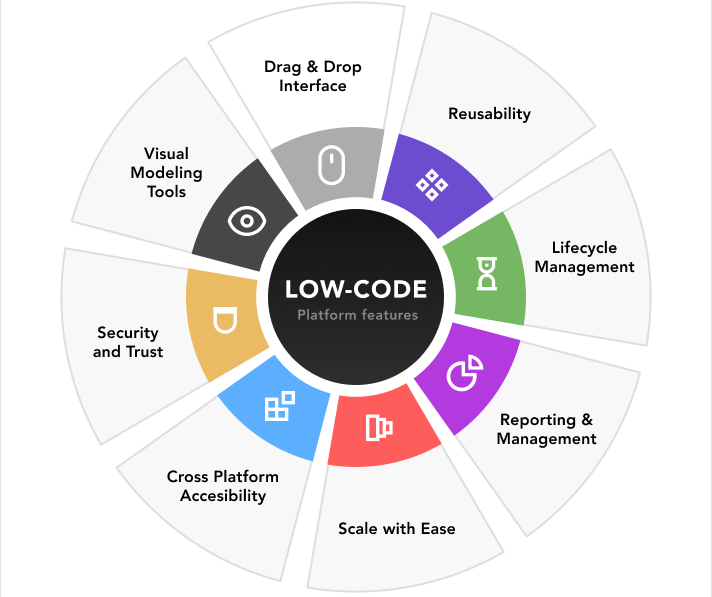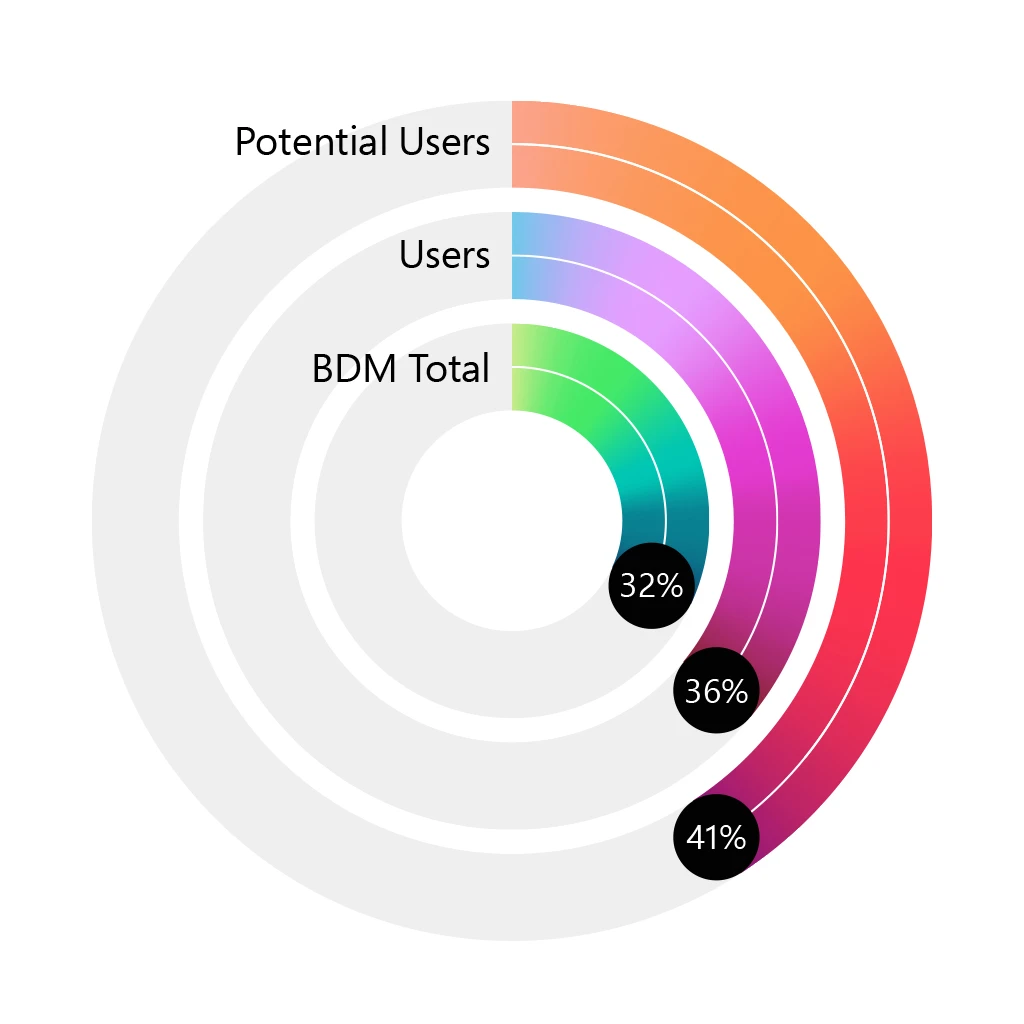The removal of impediments might at times be the key to gaining more momentum. To empower your team, you must remove the obstacles that hold them back, allowing them to utilize their abilities more effectively for greater and more noble goals. More momentum for your company means less friction for your staff.
This is why low-code/no-code (Power Apps) platforms are becoming increasingly popular among corporations; doing so will allow them to reap the many benefits that these trends provide.
The meteoric rise of Microsoft Power Platform in the past year should be enough evidence of that. Microsoft said earlier this year that sales had grown 72% from the previous year, and as of 2022, the business is now worth $2 billion annually.
For further background, here are a couple more important figures:
- There is a whopping 250% increase in the total number of power apps users from last year.
- There are almost 200k users using Power BI According to Microsoft’s prior statements, the Business Applications group has over half a million users.
- The number of platform developers currently working on apps, data analytics, and workflow automation in minimal code exceeds 5 million.
- Numerous firms across all sectors, sizes, and locations are utilizing Microsoft Power Apps, including 86% of the Fortune 500.
According to Gartner, “the worldwide market for low-code development technologies is projected to total $26.9 billion in 2023, an increase of 19.6% from 2022.“
So, why are low-code/no-code platforms and apps so revolutionary, and what are their advantages? Let’s explore.
Low-code development platforms empower organizations to create robust and scalable applications with significantly reduced manual coding requirements. This approach democratizes the software development process, allowing not only seasoned developers but also business analysts and other non-technical professionals to contribute to application creation.
By abstracting complex coding tasks into intuitive visual interfaces, low-code platforms streamline the development life cycle, accelerating time-to-market for crucial applications. The result is increased agility and flexibility, enabling businesses to respond swiftly to changing market demands and stay ahead in the competitive digital landscape.
Picture this: No more waiting ages for an app to hit the market. Low-code slashes development time, giving businesses speed they need to stay competitive. But it’s not just about speed – low-code is like a bridge between the tech geeks and the business brains. It fosters collaboration between IT and business teams, breaking down traditional silos and promoting cross-functional communication.
Businesses can tweak and refine their apps on the fly, responding lightning-fast to user feedback. This isn’t just about making apps; it’s about businesses becoming superheroes in their industries, tackling challenges head-on with custom-made solutions.
Ultimately, the power of low-code software lies in its ability to democratize innovation, foster collaboration, and propel organizations towards a future where agility and adaptability are at the forefront of digital success. It is the ticket to a future where being quick on your feet in the digital world isn’t just an option – it’s the key to success.

Achieving Greater Success: Developing Competencies and Self-Assurance
A high-morale team is one of the biggest beneficiaries of a low-code or no-code strategy. Giving them greater leeway to get more done each day boosts their morale, which in turn helps your business achieve its objectives.
Microsoft found that working in low-code or no-code settings resulted in much happier employees. Key details:
- According to 82% of people who use low-code or no-code software, it allows them to enhance their technical abilities and understanding of development.
- Using low-code or no-code software has a favorable effect on user morale (up to 80%) and job satisfaction (up to 83%).
- 80% of everyone who uses or is interested in using low-code or no-code software has said they would be more loyal to a firm that helps them improve their technical skills.

Since 71% of prospective users express skepticism about their future with an organization that does not prioritize equipping its employees with technological skills, this can result in an improvement in employee retention rates as well as ease of recruiting.
Business leaders have the opportunity to cultivate a robust learning culture that effectively retains and nurtures employees by utilizing technology such as Microsoft Power Platform. By addressing the key concerns of Business Decision Makers (BDMs), these benefits contribute significantly to driving innovation and attracting and retaining talent.

What Power Platform Can Do?
Seamlessly integrating Power BI, Power Apps, Power Automate, and Power Virtual Agents, this robust suite empowers businesses to harness the full potential of their data. With Power BI, organizations gain unparalleled insights through dynamic and interactive data visualizations, facilitating informed decision-making at every level.
Moreover, Power Apps revolutionized application development, enabling both professional developers and non-technical users to create custom applications swiftly. The agility of Power Automate streamlines workflows by automating repetitive tasks, enhancing productivity, and reducing manual errors. Lastly, the inclusion of Power Virtual Agents introduces intelligent chatbots, providing a dynamic way for businesses to engage with customers and employees.
The comprehensive approach of Power Platform not only connects data across various sources but also fosters a culture of innovation, ensuring that businesses stay ahead in a competitive digital landscape. By delivering a unified and user-friendly environment, Power Platform equips organizations to navigate the complexities of the modern business world with unparalleled efficiency and agility.
What Power Platform Entitles?
Learn more about Power Platform and its four main modules by taking a look at what they can achieve for you.
What is Power BI?
Power BI, a cutting-edge business analytics tool developed by Microsoft, stands as a beacon in the scope of data visualization and analysis. In essence, Power BI empowers organizations to convert raw data into meaningful insights, facilitating informed decision-making. Its intuitive interface allows users, regardless of technical expertise, to create compelling visualizations that unveil patterns, trends, and correlations within their data. The platform seamlessly connects to a myriad of data sources, enabling users to aggregate and transform information into dynamic dashboards and reports.
Example:
Consider a scenario where a sales manager oversees the performance of a diverse sales team. With Power BI, the manager can effortlessly integrate data from multiple sources, such as CRM systems and sales databases. Through drag-and-drop functionality, the manager can create visually appealing charts and graphs that depict sales trends, regional performance variations, and product-specific insights. The interactive nature of Power BI allows the manager to drill down into specific data points, gaining a comprehensive understanding of the factors influencing sales.
What sets Power BI apart is its emphasis on collaboration and accessibility. The platform enables users to share reports and dashboards securely, fostering a culture of collaborative decision-making. Additionally, Power BI’s mobile capabilities ensure that these insights are accessible anytime, anywhere. Whether in the office or on the go, stakeholders can stay connected to the pulse of their data, promoting a responsive and agile approach to business management.
What is Power Apps?
Power Apps platform allows users to design custom applications through a no-code or low-code approach, ushering in an era where innovation is not confined to IT departments alone. With a user-friendly interface and drag-and-drop functionality, Power Apps enables business users to translate their unique ideas into functional applications without the need for extensive coding skills.
Example:
Suppose the team identifies a need for a specialized mobile app to streamline order processing during on-site client visits. Traditionally, such a request might involve lengthy development cycles and high costs. However, with Power Apps, a sales representative equipped with a vision for the app can swiftly create a prototype. By selecting predefined templates, dragging and dropping elements like buttons and forms, and configuring data connections to existing systems, the salesperson transforms their idea into a functional app.
In essence, Power Apps exemplifies a paradigm shift, making application development more inclusive and agile.
What is Power Automate?
Power Automate is a versatile and user-friendly tool designed to empower both technical and non-technical users to automate repetitive tasks across a myriad of applications and services. By seamlessly connecting disparate systems and orchestrating complex processes, Power Automate liberates valuable time and resources.
Example:
Imagine a scenario where a business relies on a combination of Microsoft Forms for data collection and SharePoint for data storage. With Power Automate, a seamless workflow can be established, automating the transfer of form responses directly into a designated SharePoint list. This not only eliminates the need for manual data entry but also ensures data accuracy and consistency, all while minimizing the risk of human error.
This democratization of automation empowers employees from various departments to contribute to efficiency gains within their workflows. Whether it’s automating email notifications, updating records in Dynamics 365, or triggering actions based on specific conditions, Power Automate’s simplicity fosters a culture of automation adoption across the entire organization.
What is Power Virtual Agents?
Power Virtual Agents allows businesses to seamlessly automate routine tasks and engage with customers or employees through natural language conversations. With a drag-and-drop interface, users can design chatbot workflows, define conversation paths, and integrate with various data sources without delving into complex coding languages.
Example
Consider a customer support scenario where a company wants to enhance its service by providing instant assistance. Using Power Virtual Agents, they can design a chatbot that guides users through common troubleshooting steps. The chatbot, with its natural language processing capabilities, understands user queries and responds with relevant solutions. It can access knowledge bases, databases, or other integrated systems to provide accurate and personalized information.
Power Virtual Agents exemplifies the democratization of technology, allowing individuals across diverse roles to harness the power of artificial intelligence and automation, ultimately transforming how businesses interact with their audiences.
Empower Your Team with the Power of Low-code Apps
It’s time to unlock unprecedented agility and efficiency in app development without the need for extensive coding expertise. Dynamics Solution and Technology stand at the forefront of this transformative wave, offering seamless integration solutions tailored to your unique business needs. By leveraging our expertise, you not only streamline operations but also empower your teams to innovate faster.
Embrace the future of business technology with confidence – contact us here for a smooth and tailored integration experience that paves the way for a more agile and competitive tomorrow.







